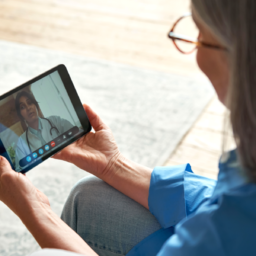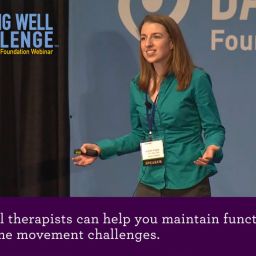Maintaining your independence isn’t simply keeping your driver’s license or staying in your home as long as possible. Independence means living your life as fully and richly as you can.
Avoid the trap of thinking independence means being self-sufficient or being able to “go it alone.” Everyone exists in a network, and we all rely on others to some extent. Being independent doesn’t mean being isolated. In many situations, our greatest strength emerges from our communities. This is supported by research: Being alone can worsen quality of life and increase mortality risk in older adults.
Further, Ahn et al. reviewed 58 studies related to social withdrawal in Parkinson’s. They found social withdrawal had multiple causes and was associated with multiple negative outcomes, including increased risk of developing dementia.
TIPS FOR MAINTAINING YOUR INDEPENDENCE
Maintaining your independence while living with Parkinson’s is complicated, in part because Parkinson’s affects so many different parts of your life and often increases the importance of your support community.
There are multiple aspects of maintaining independence while living with Parkinson’s, but everyone has their own circumstances, needs, and values. Please consider this post as an overview of what it may mean for you to maintain independence as Parkinson’s progresses and as you age.
AGING IN PLACE AND LONG-TERM CARE FACILITIES
Safarpour et al. found that nearly 25% of people with Parkinson’s on Medicare live in a long-term care facility. Dementia and hip-fractures are the most common reasons a person with Parkinson’s moves into to a long-term care facility.
A 2021 study found that 71% of people over 50 said they were unwilling to live in a nursing home. It is important to consider, however, that there are different types of long-term care facilities, including board-and-care homes, assisted living centers, continuing care retirement communities, and nursing homes. There are also senior communities that primarily offer social supports that encourage older adults to maximize a sense of community, like neighborhoods that require residents to be over a certain age. If it becomes too difficult to remain in your home: Don’t despair. You have many options.
WAYS TO REMAIN AT HOME AS LONG AS POSSIBLE
Despite the value of long-term care facilities, many people would prefer to stay in their own home. We have covered ways to prepare your home for advancing Parkinson’s in a four-part series: Part 1, Part 2, Part 3, and Part 4. We’ve also discussed ways occupational therapists can help you remain in your own home as long as possible.
Start planning and making modifications to your home and your routines as early as possible. Because falls are so prevalent for many people with Parkinson’s, prioritize minimizing fall risk. For example, move obstacles and tripping hazards out of walkways, install motion sensor lighting or use nightlights, and ensure easy access to bathroom facilities by installing a walk-in shower. If possible, minimize the need to go up and down stairs: A single-story home with no stairs is optimal.
Living alone presents a range of unique challenges. View our resources for living alone with Parkinson’s here.
ACCESSING CARE: APPOINTMENTS, TELEHEALTH, AND AT-HOME CARE
Getting to appointments with your care team can be a challenge even in the early stages of Parkinson’s, so it’s important to know the variety of ways you can access healthcare.
Make use of telehealth and in-home visits as needed. It might, for example, be a good idea to schedule winter appointments as telehealth visits to avoid traveling in snowy or icy conditions.
Although your neurologist may not do home visits, your physical and occupational therapist might. Ask your providers what your options are, and be sure to check with your insurance about coverage for home care. Many insurance policies provide coverage for home visits by physical and occupational therapists.
COGNITIVE ISSUES
Parkinson’s contributes to multiple cognitive issues. Three of the most common are mild cognitive impairment (MCI), Parkinson’s disease dementia (PDD), and Parkinson’s disease psychosis (PDP).
MCI does not typically limit your ability to perform daily tasks. In contrast, PDD often does. With PDD you may forget your medication or even forget to eat regularly. PDD may also include visual disturbances, decreased ability to control your attention, and impaired executive function. People with PDD also experience apathy, anxiety, and depression. PDP generally includes prominent, recurrent hallucinations, delusions, and illusions.
There are ways to manage these different cognitive aspects of Parkinson’s, so share your cognitive concerns with your care team. Earlier intervention can make a large impact on quality of life and help you avoid complications of cognitive effects of Parkinson’s, which include increased mortality.
COMMUNICATION
We often hear from people with Parkinson’s that speech issues are among the biggest challenges to maintaining independence.
Meeting with a Speech Language Pathologist (SLP) can help maintain the strength of your voice and speaking ability. You may have local providers in your area, but the Parkinson Voice Project also has free resources, including group and individual sessions.
A longer-term way you can help with improving independence and quality of life is through the Speech Accessibility Project. This project aims to improve the ability of voice recognition software to recognize voice patterns of people with Parkinson’s.
EXERCISE
We also often hear from people that their motor and non-motor symptoms improve when they regularly exercise. This is increasingly backed by evidence from research. Any exercise helps; even stretching and mobility work that can be done from a seated position.
FAMILY AND FRIENDS
Social isolation increases risk of mortality. Unfortunately, many Parkinson’s symptoms—from motor symptoms to apathy—can influence your desire to be social. Worse, as Parkinson’s progresses, symptoms like changes to your voice and mobility can make it difficult—and sometimes impossible—for you to socially engage as you once did.
To increase your quality of life and ability to remain independent, prioritize social relationships and do this as early in your life with Parkinson’s as possible. Being around people can help make everyday tasks like making dinner easier and more enjoyable; being with people has other benefits, too.
Having a strong community can expose you to new ideas and experiences. Close friends and family may help you notice changes in your symptoms; this can help you convey the most accurate information to your care team. Being aware of more perspectives can be especially helpful with management of ON-OFF fluctuations, mood-related issues, and DBS programming.
Living with Parkinson’s can feel embarrassing like if you spill food at a restaurant or fall in public. These possibilities can make it difficult to remain motivated to stay socially engaged, but if you keep those who love you close early in your life with Parkinson’s, staying socially active will be easier.
Share your experience of Parkinson’s with those closest with you; do so in writing or record an audio message if that’s easier. Find things to do together that continue to inspire you: listen to music, watch movies, play games. People with Parkinson’s sometimes experience a newfound artistic creativity, so you might be pleasantly surprised if you try something new. Whatever you choose to do together, one of the best ways to remain independent is to maintain your social connections and continue to learn and closely live with those you love.
FINANCES AND INSURANCE
Financial planning and having adequate health coverage are essential components of remaining independent.
While everyone’s individual circumstances are different, here are some core pieces of advice:
- Understand your state’s Medicaid and the federal Medicare standards.
- Be familiar with support services that can help with medical bills.
- Find ways to cut healthcare costs.
- Read about federal programs that can help you lower costs on housing, home repair, energy bills, and more.
- Find a financial advisor to help you evaluate your financial resources and needs, but be careful.
- Consult with an expert in your area about requirements for disability-related healthcare coverage and financial assistance—the National Disability Rights Network and Library of Congress are good places to start.
MOBILITY
As your Parkinson’s progresses, you may need to adjust how you get around—both on foot and in other ways.
Gait issues like freezing of gait can make it scary and even impossible to get around on foot. There are tools that can help, from conventional trekking poles to specialized walking aids like Urban Poling’s Activator device and NexStride. The key is to become comfortable with using these mobility aids early. Many people find it helpful to collaborate with a physical therapist on how to use them.
At some point, you may also have to consider whether it is safe for you to drive. This can be an extraordinarily difficult moment, largely because of the sense that if you give up your license, you’ll be losing your independence.
Many municipalities have mobility programs to help people with health issues access public transportation services, and with the development of services like Lyft and Uber, there are many options to help people get around. Care.com and AAA have advice about transit access. The AAA site also shares resources for helping you evaluate your ability and improve your driving skills.
NUTRITION
Nutrition is one of the major challenges of living with Parkinson’s. One reason for this relates to the mobility issues described above. If you have difficulty driving, it may be a challenge for you to get to the grocery store. If you have difficulty walking, it may be difficult for you to shop even if you can get to the store.
Fortunately, there are services that can help. In addition to longstanding options like Meals on Wheels, services like Instacart, and other store-specific services now offer home delivery of your groceries from your local store.
Additionally, meal-kit services like Blue Apron, Hello Fresh, and others are also excellent resources to help you access fresh food at home. These services can be great to expand your culinary horizons, since you can usually select from a large database of recipes. As a bonus, some meal-kit plans can send your food pre-cut, which saves time and is helpful if your symptoms make it difficult for you to safely use a knife.
A NOTE ON FOOD SAFETY
Almost everyone living with Parkinson’s experiences diminished sense of smell. This can cause safety issues at home, from gas leaks to expired food. There are sensors to help alert you to leaking gas, but noticing when food is no longer safe can be more challenging.
Still, there are strategies to help avoid food safety issues: Always check expiration dates and understand what they mean, look for discoloration and mold, and maintain your refrigerator to ensure it holds a steady temperature. Large fluctuations in temperature accelerate food going bad
BEING TRUE TO YOURSELF
The tips and advice above can help you maintain your practical independence, but it’s also important to maintain the independence of your inner life.
To live well with Parkinson’s, you need access to good food and good medical care, but you also need to maintain your independence of thought. The brain is not a muscle, but there are reasons to strengthen your mental muscles.
Broadly reading, continuing to learn, and practicing critical thinking—not just about Parkinson’s but everything you encounter—can help you work against apathy and remain engaged in your life.
Parkinson’s is tough, but with planning, preparation, and a little bit of focused effort, you can maintain your independence and live full and deeply satisfying life with Parkinson’s.
ADDITIONAL RESOURCES
10 Things to Know about Medicaid
Knowing When It’s Time for In-Home Help













